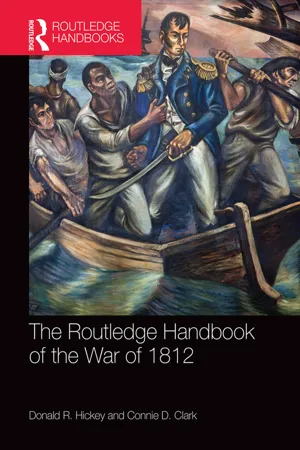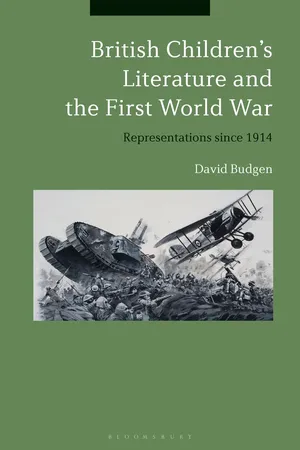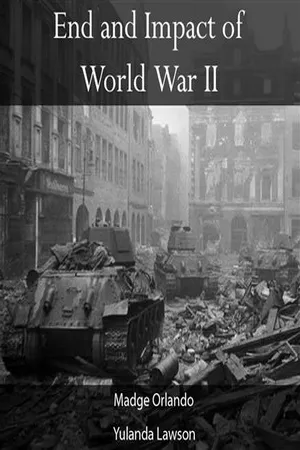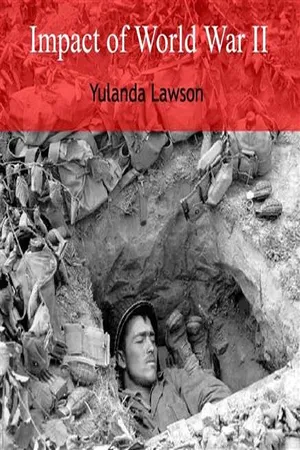History
American Homefront
The American Homefront refers to the social, economic, and political conditions in the United States during World War II. It was a time of great change as women entered the workforce in large numbers, rationing was implemented, and the government took on a greater role in the lives of citizens. The Homefront played a crucial role in supporting the war effort and ultimately contributed to the Allied victory.
Written by Perlego with AI-assistance
Related key terms
1 of 5
6 Key excerpts on "American Homefront"
- eBook - ePub
- Donald R. Hickey, Connie D. Clark(Authors)
- 2015(Publication Date)
- Routledge(Publisher)
11The American Home Front, 1812–1815J.C.A. StaggWhat do historians speak of when they describe the “home front” during a war? There are several ways in which this question might be approached and they are not always compatible. Many scholars separate accounts of civilian life during wartime from the narratives of military campaigns; they assume that the former did not necessarily impact the latter. From this vantage point, studies of the home front can embrace a wide variety of phenomena that cannot be categorized clearly as the history of combat. Other writers, drawing on recent developments in the fields of military and social history, have dissolved this distinction by stressing the permeability of the military and civilian spheres; they maintain that the two constantly interact and cannot be meaningfully separated. Pushed to its logical conclusion, this approach has given rise to the notion of “transformational” war, conflicts in which the demands of mobilization and battle can be so great that they inexorably reshape pre- war patterns of culture, economic activity, politics, and social structure in ways that produce significant and long- lasting change.How might the War of 1812 be understood from these perspectives?At first sight, it could be surmised that because the war was of relatively short duration (32 months) and because mobilization seemed neither extensive nor effective—contemporary counts found little more than 34,000 men in the U.S. Army by 1815 from a population of just over 8 million—that the lives of the vast majority of the citizenry were unaffected. Most people experienced the war vicariously, either by reading newspapers and pamphlets or by hearing word- of- mouth accounts of its events; otherwise they pursued their daily routines on farms, in workshops, and on the waterfronts with only occasional disruptions. Such a conclusion, however, risks ignoring what we have learned from the “new military history,” most notably the awareness that mobilization and campaigning should not be considered apart from the social, cultural, and political characteristics of the people who were called upon to shoulder the burdens of war. - eBook - PDF
Home/Fronts
Contemporary War in British Literature, Drama, and Film
- Janina Wierzoch(Author)
- 2020(Publication Date)
- transcript Verlag(Publisher)
The myth purports an “unprecedented social and moral solidarity” of the British in the face of “total war,” epitomised in the experiences of the Blitz and Dunkirk (Harris 17-18). Considering the famous civilian flotilla disembarking once again to save ‘our’ troops in the 2017 blockbuster Dunkirk , the myth still keeps today (Ro-driguez). In reality, Jose Harris notes, neither the distribution of wealth, the indus-try, nor class or gender roles were revolutionised in the ways the Home Front myth suggests; resistance, discontent, and despondency were very well present in Britain at the time (19). Though television series have, in recent years, touched upon aspects that challenge the image of “the ‘People’s War,’” cultural production in general has kept alive the association of the home front with World War II, “Britain’s ‘good war,’” as Maggie Andrews writes in her contribution to The Home Front in Britain (2014) (235-236). The articles in this volume, edited by Maggie Andrews and Janis Lomas, give an outline of established themes of the discourse on the British home front in the World Wars, such as domesticity and work as well as femininities and masculinities. The idea of home/front in this study does not directly relate to such established notions of the term home front . Not only do the realities of historical and present life in Britain di f fer as to how war interferes with home society; in the present project, the home/front is also located on an abstract, figurative level to present 5 The Oxford English Dictionary defines home front as the “civilian life and population of a country … engaged in military conflict elsewhere, … another front in a consolidated war e f fort.” 2. Contexts and State of Research 39 the narrative process of con flating war and home in the examined fictions. And yet, references to previous home front contexts are not entirely without relevance. - eBook - PDF
British Children's Literature and the First World War
Representations since 1914
- David Budgen(Author)
- 2018(Publication Date)
- Bloomsbury Academic(Publisher)
Those authors writing before the Second World War had tended to concentrate on the experience of either combat or adventures set around the front lines. During this period, the home front had simply been the starting point for the protagonists’ adventures, while the few exceptions were often aimed at a young female audience. In short, fiction of the war years focused on the abnormalities of wartime Britain, and not the experience of everyday life. This changed after the Second World War. Post-1945 depictions of the Great War utilized the home front setting more frequently. The massive social upheaval brought about by the two world wars contributed to the shift towards such narratives. As the First World War increasingly came to be seen as a historical aberration, its representations in popular culture came to reflect and inform public understandings of the conflict. Moreover, in academia, the scope of historical research was increasing; social and cultural histories of the conflict became more important. This led to different understandings of both world wars, and affected popular perceptions of the conflicts. More modern depictions of the home front during the First World War seem to have been partially inspired by the more recent experiences of the Second World War. Modern writers and audiences had developed a greater understanding of the importance of the home front in wartime. Indeed, this perception of British society – often exploited by propagandists – had a long-lasting effect on popular memory; the ‘spirit of the Blitz’, for example, is still invoked at times of crisis. 1 During the First World War, society had focused on those who had borne the brunt of the loss and suffering: military personnel. Civilians came more to the forefront in the Second World War. That war’s greatest horrors –invasion, occupation, genocide – had not physically affected the British people. - eBook - PDF
Beyond Narrative
Exploring Narrative Liminality and Its Cultural Work
- Sebastian M. Herrmann, Katja Kanzler, Stefan Schubert, Sebastian M. Herrmann, Katja Kanzler, Stefan Schubert(Authors)
- 2022(Publication Date)
- transcript Verlag(Publisher)
The Army, the profession of soldiering, and the making of war are all ostensibly masculine domains” (MacLeish 18). De-spite queer families, transgender soldiers, and male spouses gaining more and more public attention, the dominant image of the military spouse continues to be coded as feminine. Home Front Autobiographies of the ‘War on Terror’ 189 As they navigate the unnarratability / unrepresentability of the experience of war 2 at the home front, these texts draw on and activate readers’ emotional knowledge about family and romantic love and they use their authors’ experiential knowledge as authorization. These strategies are especially crucial to af fectively interpellate a civilian readership that is largely detached from its armed forces and increasingly ignorant of military culture and the e f fects of war on military families. 3 Ultimately, home front autobiographies rely on various forms of tacit knowledge—especially on “bodily knowing” and “emotional understanding” (Shotwell x) 4 —in order to ex-pand the limits of their narrative form and to fuel their highly ambivalent “cultural work” (Tompkins). This work entails promoting US warfare while simultaneously showing its detrimental ef fects on the home front. It also means empowering mili-tary spouses by making their sacrifice and resilience visible while at the same time transposing the war almost exclusively to the home front and potentially losing sight of the battlefields and of the victims of US warfare. - No longer available |Learn more
- (Author)
- 2014(Publication Date)
- College Publishing House(Publisher)
________________________ WORLD TECHNOLOGIES ________________________ Chapter 11 Home Front during World War II U.S. Government Publicity photo of American machine tool worker in Texas The home front covers the activities of the civilians in a nation at war. World War II was a total war, homeland production became even more invaluable to both the Allied and Axis powers. Life on the home front during World War II was a significant part of the war effort for all participants and had a major impact on the outcome of the war. Governments became involved with new issues such as rationing, manpower allocation, home defense, evacuation in the face of air raide, and response to occupation by an enemy power. The morale and psychology of the people responed to leadership and ________________________ WORLD TECHNOLOGIES ________________________ propaganda. Typically women were mobilized to an unprecedented degree. The success in mobilizing economic output was a major factor in supporting combat operations. Overview The major powers devoted 50 –61% of their total GDP to munition production. The Allies produced about three times as much in munitions as the Axis powers. Munitions Production in World War II (Expenditures in billions of dollars, US 1944 munitions prices) Country/Alliance Year 1935-9 ave 1940 1941 1942 1943 1944 Total 1939–44 U.S.A. 0.3 1.5 4.5 20.0 38.0 42.0 106.3 Britain 0.5 3.5 6.5 9.0 11.0 11.0 41.5 U.S.S.R 1.6 5.0 8.5 11.5 14.0 16.0 56.6 Allies Total 2.4 10.0 20.0 41.5 64.5 70.5 204.4 Germany 2.4 6.0 6.0 8.5 13.5 17.0 53.4 Japan 0.4 1.0 2.0 3.0 4.5 6.0 16.9 Axis Total 2.8 7.0 8.0 11.5 18.0 23.0 70.3 Source: Goldsmith data in Harrison (1988) p. - No longer available |Learn more
- (Author)
- 2014(Publication Date)
- Research World(Publisher)
________________________ WORLD TECHNOLOGIES ________________________ Chapter-5 Home Front during World War II U.S. Government Publicity photo of American machine tool worker in Texas. The home front covers the activities of the civilians in a nation at war. World War II was a total war, homeland production became even more invaluable to both the Allied and Axis powers. Life on the home front during World War II was a significant part of the war effort for all participants and had a major impact on the outcome of the war. ________________________ WORLD TECHNOLOGIES ________________________ Governments became involved with new issues such as rationing, manpower allocation, home defense, evacuation in the face of air raide, and response to occupation by an enemy power. The morale and psychology of the people responed to leadership and propaganda. Typically women were mobilized to an unprecedented degree. The success in mobilizing economic output was a major factor in supporting combat operations. Overview The major powers devoted 50–61% of their total GDP to munition production. The Allies produced about three times as much in munitions as the Axis powers. Munitions Production in World War II (Expenditures in billions of dollars, US 1944 munitions prices) Country/Alliance Year 1935-9 ave 1940 1941 1942 1943 1944 Total 1939–44 U.S.A. 0.3 1.5 4.5 20.0 38.0 42.0 106.3 Britain 0.5 3.5 6.5 9.0 11.0 11.0 41.5 U.S.S.R 1.6 5.0 8.5 11.5 14.0 16.0 56.6 Allies Total 2.4 10.0 20.0 41.5 64.5 70.5 204.4 Germany 2.4 6.0 6.0 8.5 13.5 17.0 53.4 Japan 0.4 1.0 2.0 3.0 4.5 6.0 16.9 Axis Total 2.8 7.0 8.0 11.5 18.0 23.0 70.3 Source: Goldsmith data in Harrison (1988) p.
Index pages curate the most relevant extracts from our library of academic textbooks. They’ve been created using an in-house natural language model (NLM), each adding context and meaning to key research topics.





